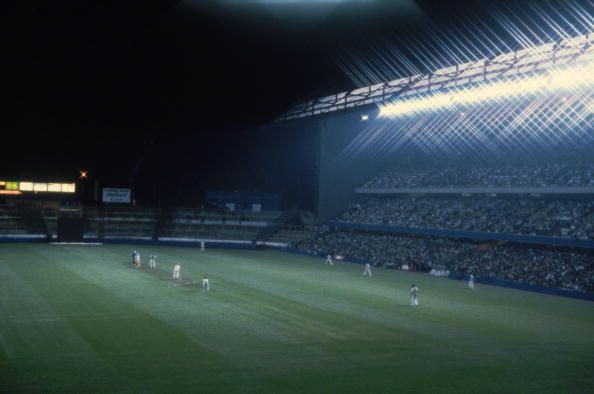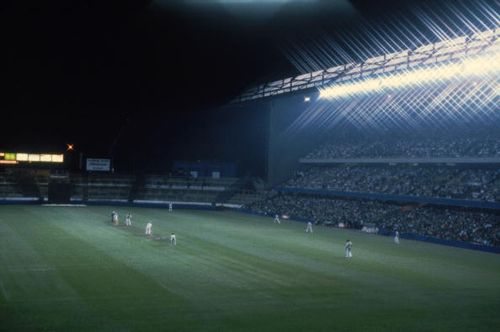
August 24, 1980 - When cricket took the centre stage at Stamford Bridge

Essex vs West Indies at Stamford Bridge
The disruptive innovations brought about by Kerry Packer’s World Series Cricket in the 1970s changed the game forever.
The concepts of coloured kits, use of white balls and black sightscreens, and matches played under floodlights gained a lot of popularity. The cricket purists in England balked at the idea, but it was clear that the changes would be given a try on the English soil sooner rather than later.
The one major hurdle in implementing the radical changes in England was that the only stadia with floodlights were the football ones, which were not easily accessible due to Football League commitments.
The disadvantage of playing cricket on a football ground was that the field was longer and narrower, and any decent hit played sideways was almost assured of a boundary. There had been a trial game at Highbury (Arsenal‘s home-ground) way back in the 1950s, but that was a benefit match, and wasn’t taken very seriously.
Surrey took the initiative in 1980 to organize a game at Stamford Bridge, Chelsea FC’s home-ground, and roped in the West Indies cricket team, which was touring England then, to play a match there on 24th August.
The idea of using the venue for hosting cricket matches was approved by none other than Packer himself, who had previously sent scouts to England to explore venues where he could host WSC matches.
Surrey’s manager Micky Stewart stressed that the proposed game was a serious one and not just a gimmick. “This will be a highly competitive match and not just a staged event.”
Harry Brind, who was a groundsman at Stamford Bridge, also held the same post at The Oval. Having expertise in preparing grounds for cricket matches, he was brought in to supervise the work for the match.
A drop-in wicket preparation proved too problematic, and an artificial pitch was used instead. Also, Chelsea’ electronic scoreboard was unable to display the relatively more complicated cricket scores, and hence a mobile scoreboard was borrowed from Essex.
Dug outs were set up for players to be seated, while not playing on the field. (Interestingly, dug outs later made a re-entry in cricket with the advent of the Twenty20 format.)
Unfortunately for Surrey, their Gillette Cup semifinal game spilled over to the second day due to rain, and they were unable to participate at Stamford Bridge, in a game which was their brainchild. They had specially ordered a chocolate brown kit for the occasion, and were unable to show that off to the public.
Essex stepped in for Surrey instead, and the game started at 5:30 pm. West Indies batted first and made a slow and cautious start, and Viv Richards took 15 minutes to get off the mark.
However, he soon found his mojo and blasted 53 runs in the next 18 minutes, which included 20 runs off four consecutive deliveries from David Acfield.
Collis King continued the form that he displayed in the 1979 World Cup final with a brutal innings of 56, which included a six that broke the umbrella of a spectator.
Faoud Bacchus joined the fun as he scored a quickfire 87 not out, with 6 sixes, and West Indies scored 247 for 9 in 40 overs. John Lever took 4 wickets while Graham Gooch picked up 3.
In reply, Essex had a slow start as well, and they lost their first wicket at the score of 14 in the fourth over. Graham Gooch and Ken McEwan decided to pick up the tempo, and a flurry of runs followed.
Gooch in particular was on a rampage as he hit 10 sixes, including 3 of them off consecutive deliveries from Richards. McEwan supported Gooch brilliantly in the chase.
At about 9 pm, with the score at 192 for 1 off 28 overs (Gooch on 111* and McEwan on 67*), persistent rain led to the game being abandoned. Essex was awarded the game by virtue of them having the faster run-rate, and Gooch was declared the man-of-the-match for his all-round display.
Despite the weather curtailing the match, the event was deemed successful. The official attendance of spectators was 11,073 and more than £50,000 was generated through ticket sales and sponsorship.
Two days after the match, Chelsea played a 2-2 draw with Wrexham at Stamford Bridge. As the game was reaching its completion, the bored crowd chanted “We want cricket!”
In the following year, there was a county tournament played on football grounds after seeing the success of the game at Stamford Bridge. However, it was a commercial failure as interest levels were surprisingly low.
But the evening of August 24, 1980 at Stamford Bridge laid the foundation for cricket to be played under floodlights in England, something which became a trend almost a decade later, and now is widely popular all across the world.